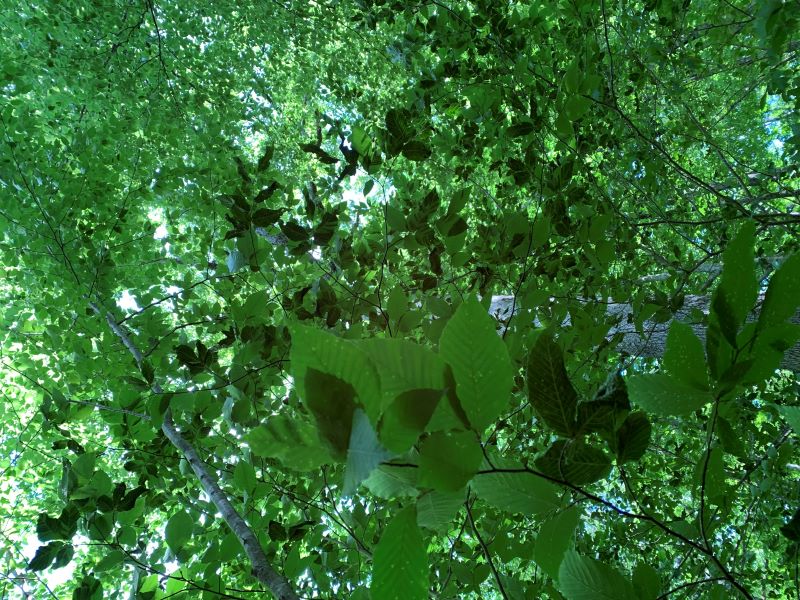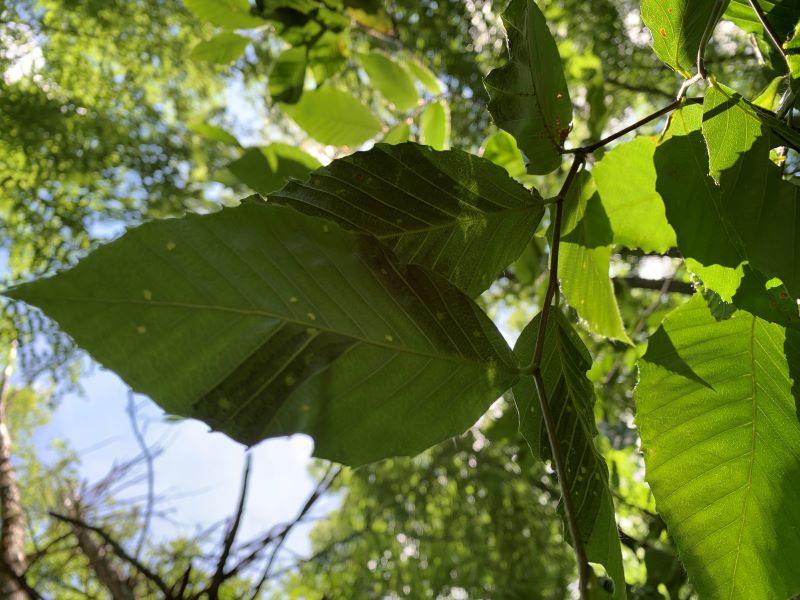
By Christa Lessing, VAAFM Plant Health Technician
The American beech (Fagus grandifolia) is a majestic tree, capable of growing up to 70 feet in height, with a canopy spread of 40 feet. They are beloved ornamentals and important forest trees recognizable by smooth grey bark (often carved with the initials of young couples), pointed leaf buds, and in the winter, the dead leaves remaining on the branches. Of course, if you knew all that already, you’ve probably heard whispers of a novel beech disease that affects developing leaf buds. If you’ve been out of state for a summer vacation in the last few years, you may have seen it. How would you know if beech leaf disease, often abbreviated as “BLD”, has infected your beech trees?
The first cases of BLD were found in 2012, on American beech in Ohio.[1] Researchers soon realized the threat that the disease posed to North American forests and raced to find the causal agent. In 2020, researchers at the USDA found that a species of nematode (a roundworm), Litylenchus crenatae subspecies mccannii, would consistently appear wherever the disease did.[2] There is strong evidence to suggest that the nematode is responsible for the symptoms of BLD, but there is some debate on the role of several bacterial and fungal strains also associated with the infection.

Learning the identity of the pest is the first big step to fighting against it, but at this point, the knowledge gap is still enormous. Unfortunately, we know very little about the organism, its life cycle or how it spreads. We do know that the nematodes cause damage to developing leaf buds, which makes the new leaves come out with bands of dark, thickened or blistered tissue between veins. This makes for a highly distinctive banding pattern easiest to see when standing under the leaves and looking up at a light source, like the bright sky. BLD is fatal and has been observed to take 6-10 years to kill a tree as the nematodes cause more damage (though this may not hold true in New England), with younger trees often dying faster.[3] As it progresses, the damage to the leaves becomes more extreme. They can become curled, deformed, dark green or yellow, and may drop prematurely. Eventually, the trees become unable to produce new leaves and die.
It’s unclear how the pest spreads, though its rapid progression though the country has led to some speculation about spread through vectors including birds, insects, and humans. BLD has spread rapidly though southern New England since its first detection in Connecticut in 2020. It has since been found in Rhode Island, Massachusetts, Maine,[4] and New Hampshire.[5] It is not currently known to be in Vermont.
Even in the absence of BLD, beech trees in the state may have experienced damage from other stresses. To start, this year’s late-May freeze event caused a lot of leaf die-back in species like beech. Native mites and insects like the beech leaf rolling aphid can cause the leaves to yellow, thicken, and curl in a way that may resemble late-stage BLD to the unwary observer.[6] Among all of these different types of damage, the symptom that best indicates whether a tree has BLD is the highly distinctive dark bands between the veins of the leaves- so if you think you see the stripes in ANY leaves on a beech tree in VT, be sure to report it here. While not a strong BLD look-alike, it is also worth noting the prevalence of beech bark disease (BBD). Caused by an insect-fungal complex, BBD is characterized by rough-looking, blistered bark. This complex, which has been widespread in Vermont for many years, may make trees more susceptible to BLD.
At this time, there is no effective treatment for BLD (for ornamentals or forest trees). Considering that, it’s clear that we’re facing a drastic change in our forests, though it is difficult to speculate on the exact impact that losing our beech trees will have. Beech trees are known to provide valuable habitats and food for wildlife. They are a staple in Vermont forests, which can consist of 40% beech.[7]
C. S. Lewis wrote about the elegant beech in his book The Prince Caspian. In a passage that stays with me to this day, a spirit of one of these trees was described as “a precious goddess, smooth and stately, the lady of the wood”. Anyone who has beheld a full-grown beech can appreciate exactly what Lewis was trying to capture. It’s heartbreaking to think that future generations may not have the chance to get to know this tree. With what limited information we have to work with, our best chance against BLD (and other pests and pathogens yet to emerge) is to prevent its spread as much as we can and to keep learning more about it. As always, don’t move untreated wood (firewood or otherwise) from place to place. If you think you’ve spotted BLD, help us keep track by reporting it here: https://vtinvasives.org/get-involved/report/reporting-a-tree-disease.
[1] Ewing, C. J., Hausman, C. E., Pogacnik, J., Slot, J., & Bonello, P. (2019). Beech leaf disease: An emerging forest epidemic. Forest Pathology, 49(2), e12488
[2] Carta, L. K., Handoo, Z. A., Li, S., Kantor, M., Bauchan, G., McCann, D., ... & Burke, D. J. (2020). Beech leaf disease symptoms caused by newly recognized nematode subspecies Litylenchus crenatae mccannii (Anguinata) described from Fagus grandifolia in North America. Forest Pathology, 50(2), e12580.
